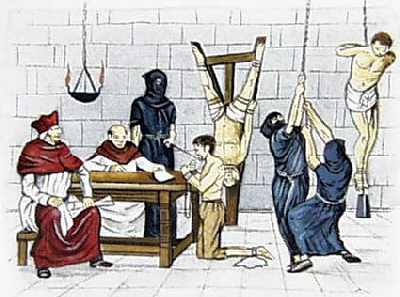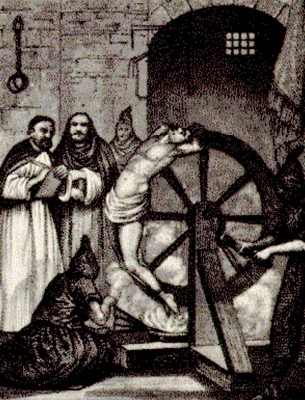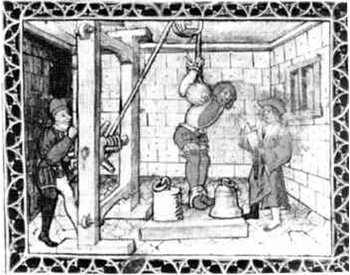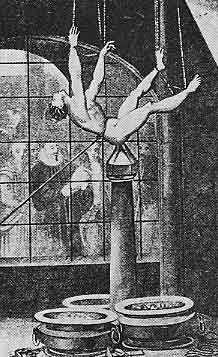Search our Archives:
» Home
» History
» Holidays
» Humor
» Places
» Thought
» Opinion & Society
» Writings
» Customs
» Misc.
|
October and Torquemada
© 2010 by Jane Bichmacher de Glasman*
In October of 1483, the most known, hated, frightening and expressive figure appeared in the Spanish Inquisiton scenery: the Dominican monk Thomas de Torquemada (town that supplied him with the surname, which ironically means burnt or cremated tower). His name is almost synonymous of Inquisition and fanatical atrocity. He was nominated by the catholic kings (of whom he was a confessor) as General-inquisitor of Castile, Aragon, Lion, Catalonia and Valencia, with the Pope’s consent.
In October, 17th, 1483, a papal bulla established the “Consejo de La Suprema y General Inquisición” (Council for the Supreme and General Inquisition) to act as its highest authority; the post of General Inquisitor was created and the first occupant was Torquemada. He was responsible for almost half of the people cremated in the Spanish Inquisition during all its history: until 1490, about 100,000 processes were opened, followed by 2,000 executions (burnt alive) and 15,000 strangled. The formal objective of the Inquisition was to suppress the heresy, what, for Torquemada, was a synonym of Crypto-Jews elimination.

Remember that in the second half of 15th century, the Iberian Peninsula had more converted Jews than any other place of the world. Occupied during centuries by the Muslims, who granted to the Jews freedom of worship, it had been a stage of intense exchange between Christian, Muslim and Jewish cultures. With the progressive unification of Spain (the union of Lion and Castile kingdoms and, later, Aragon), Muslim and Jewish were pushed gradually to the south, obliged to migrate to north of Africa, or to convert forced to Christianity. This option was always seen with suspicion since it was caused by religious pursuit, it was only apparent that in the intimacy of their homes, many Jews were keeping in secret on practicing the old religion.
Torquemada exploited the popular suspicion and the national necessity to count only on “sangre limpia” (clean, pure blood), i.e. purely Christian blood. In practice, it was a fiction; as Spain had the biggest Jewish community of medieval Europe and inter-ethnic marriages and conversions were common, very little people had really "pure" blood. Torquemada himself was a grandson of anusim, (forced converts) but he didn’t let this detail bother him; he decided to purify the country. He developed a methodical, cold and merciless work of pursuit to the cripto-judeus that resulted in the death of thirty thousand victims.

To stimulate the accusations, the Inquisition published a set of directions to teach the Catholics how to watch their neighbors and to recognize possible traces of Judaism. Torquemada wrote the instructions from 1484 to 1498, in which the Spanish Inquisition’s organizational and procedure of the regulation was fixed.
Torture was widely used when the Jew was accused of contradiction or if he denied confessing his heresy.
And from the tortures to extract confessions originated the expression “to swear with joined feet” (non-existent in English but equivalent in meaning to “cross my heart”), used to emphasize the truth of something said. In Portugal it is common to say “to swear on joined feet” and “to deny on joined feet”. In Spain, the expression is used in the sense of believing blindly in something (“to believe with the joined feet”).

The suspect of heresy against the Church had his hands and feet tied (or nailed in wooden poles or lifted in the ceiling by the feet). In this position, the accused promised quickly to say nothing but the truth. He was widely tortured until confess himself heretic or denied the charges – what was not even useful, since he would end in the dungeon for the rest of the life or in a bonfire in public square. As a matter of fact, to “deny with joined feet” also hardly would move the impassive agents of the Holy Office.

There are reasons to believe that Kol Nidrei which is a solemn plea for the divine redemption from the vows taken by Crypto-Jews in their forced conversion. Kol Nedrei was composed much earlier but it is reasoned that it became popular at this time. Many people frequented the synagogue secretly, risking their lives and used the text of Kol Nidrei like a formula of giving up the vows imposed by the Inquisition.
Still inside macabre ironies of the History, in 12th of October of 1535, Pope Paul III granted general pardon to the Crypto-Jews creating, in the following year, the Inquisition in Portugal. It was also in October, of 1765, the last public “auto de fé” carried out in Lisbon, which condemned Judaism.
While remembering the history and the past sufferings, Jewish people must proclaim, with the conviction of a surviving humanism, amid fire and blood: Torture, never again!
Published in Visão Judaica # 96,December 2010(In Portuguese)
* Jane Bichmacher de Glasman is a writer, Ph.D. in Hebrew Language, Jewish Literatures and Culture, Creator and former-director of the Program of Jewish Studies at State University of Rio de Janeiro (UERJ), Professor and coordinator of the Department of Hebrew Studies at UERJ and UFRJ (retired).
~~~~~~~
from the December 2010 Edition of the Jewish Magazine
|
|
Please let us know if you see something unsavory on the Google Ads and we will have them removed. Email us with the offensive URL (www.something.com)
|





|
